- Spokane Public Schools
- More SPS Stories
More SPS Stories
-
Spokane Public Schools Students and Staff Recognized at 2024 Chase Youth Awards
Posted by Kevin Dudley on 4/24/2024Chase Youth Awards at the Fox Theater, April 23, 2024 from Spokane Public Schools on Vimeo.
The Chase Youth Awards, Spokane's annual recognition of outstanding youth in the greater Spokane area, were handed out April 23, and students and staff from Spokane Public Schools were well represented.
SPS students and staff took home 17 of the 43 awards handed out in categories ranging from leadership to compassion to cultural awareness and more. Watch the event above, and here are the winners from SPS:
Elementary School Student: Arts and Creativity
Dakota Potter, Bryant/TEC
Dakota has always loved to sing, started taking classes and over time is getting better and better. She is so good that our brothers wrestling coach asked her to sing at a tournament where she did so well she was asked to sing the national anthem at the State wrestling tournament. She sang in front of 21,000 people at the Tacoma Dome and received major applause for her performance. One of the organizers reached out and asked her to sing the national anthem at the 2024 Women's National Wrestling Championship where she will also be on TV. Quite an accomplishment for a nine year old and a great example of how young girls can achieve great things through hard work and dedication.
Elementary School Group: Arts and Creativity
Mullan Road Elementary Kelso Kids
The Kelso Kids volunteer their time during recess and lunch to model appropriate peacemaking skills and conflict resolution. Kelso's Choices is an elementary curriculum that teaches problem solving skills to young students. These students write their own skits and demonstrate the ways to solve small problems, performing for kindergarten and first grade classrooms. They end their presentation teaching the kids a song they all perform together. These students have shown maturity, responsibility, role modeling and creativity this year.
Teen Group: Arts and Creativity
Shadle Park High School Theatre
In my 30 years of teaching, I have never seen a more diverse group of students working together, and for one play there was no such thing as a marginalized community. The entire cast should get an award, but I am particularly proud of 5 students. Dominic is the first student with Down Syndrome to take a theater class. He worked hard to break a barrier. Because of his example, 17 students with learning impairments or difficulties ended up in the theatre program. George is also a person with developmental delays. The most important thing he did was kick the door open for all students who are not neurotypical. Two of their neurotypical peers, Malaya and Alyssa really enjoyed acting with George and Dom and did an amazing job of helping them find success in the program. Finally, Jamie was the student leader for the event. She was organized and made sure all the students felt valued and heard. We recognize them for the successful inclusion of historically underrepresented students in the theatre program.
Middle School Student: Community Service
Marielle Sokoloff, Bryant/TEC
I distinctly remember walking through the door and seeing Marielle standing at the kitchen counter with a stack of paper bags, bags of bread, jars of peanut butter and jelly, and bags of oranges. She made bags complete with a water bottle, sandwich, an orange, coupled with a blanket, to hand out to homeless people she saw living on the streets of Spokane. She spent hours delivering those bags and you would never know this is a girl who is too shy to talk to new people.
Elementary School Student: Compassion
Tori Trimble, Hutton Elementary
Tori has Down Syndrome, but that's no what makes Tori different, it's her compassion, kindness and confidence that differentiates her from the rest. People always say "how does Tori know everybody?" and her mom and day always say it's because she isn't afraid to approach people and make friends. You could say that everybody needs a little bit of Tori in them. Who doesn't want a kind, sweet girl to come up and just be nice or play on the playground with kindness in their heart.
Middle School Student: Compassion
Levi Eberle, Scajawea Middle School
Levi has always wanted to help people and will often take time out of his day to help others. Levi is the youngest of five kids and rather than keep up with his siblings and their activities, he recently volunteered to regularly help his grandma with household chores. It's not common for a seventh grader to put their own interests aside to help others, but that's just his nature. His helpful nature also comes through at school in the way he interacts with his peers, always wiling to lend a helping hand wherever needed.
Teen: Compassion
Larissa Truax, Rogers High School
Larissa is one of the most observant Girl Scouts in the Council and is always looking to help others. Attending school at Rogers, she sees many needs in her neighborhood. One thing she noticed is the lack of fellowship at retirement centers. She decided to adopt a retirement center and bring some brightness there, so she brings decorations for every holiday. Christmas, Easter, 4th of July, and fall festival she adds color to the retirement center walls, bringing smiles to the residents. She also set up times with the activity director to do activities with the residents, always smiling when she comes to visit. She goes the extra mile and there are no traffic jams on that extra mile.
Teen Group: Cultural Awareness
Ferris High School Hispanic Honor Society
In conjunction with the American Association of Teachers of Spanish's new group of Ambassadors, members who are heritage Spanish speakers from around the globe who have relocated to Spokane, the Ferris Hispanic Honor Society started a Conversation Club in which both Spanish and English language learners convene weekly to practice conversational skills. This Club validates our youth's confidence and identity in heritage language and cultures, while also demystifying diversity and creating empathy among youth. In addition, they organized a partnership with the Spokane Public Language Immersion program at the Libby Center, working with students from 1st - 6th grade on Readers Theater, preparing a play called Trabajando Juntos (working together), continuing language development. There is no doubt that having serious helpers in younger language classrooms is a wonderful asset to developing multilingual youth!
Middle School Group: Innovation
Sacajawea Middle School Advanced Engineering, semesters 1 and 2
Semester 1:
After researching some of the common problems associated with Alzheimer's, the students learned that seniors living with dementia and Alzheimer's become confused and anxious about being on time. Their day is based on a schedule revolving around breakfast, lunch and dinner, and in such cases, a reliable clock designed with seniors specific needs in mind can make a significant difference in their daily lives. The students then decided to create pendulum clocks for patients at Royal Park Retirement Facility. They crafted beautiful one-of-a-kind clocks using a CAD program, laser cutters, 3D printers and measurements. When the clocks were completed the kids delivered them and met with the 30 seniors in the activity room, enjoying conversation, cookies and hot chocolate.
Semester 2:
These students chose to work with JOYA Child and Family Development Center and after being presented with a dozen challenges from the head educational specialist, they decided to focus on mobility. When students researched wheelchairs, they were shocked to learn that they are made for mass market and haven't really changed over the last four decades. Students build wheelchairs with the newest digital technology to give two boys mobility, safety and accessibility. The students began with a Porsche car seat, using it as a base and built a removable robotic wheelchair custom-made for each of the boys. One of the boys was unable to use his arms so students created a joystick he could move with his chin. Students also invented three smaller wheelchairs and tummy devices to improve children's core strength; a visual and tactile light wall similar to a light bright that teachers, parents and students can manipulate to create words, pictures, or just work on hand-eye coordination; and ten therapy toys for all students at JOYA.
Elementary School Group: Leadership
Wilson Elementary Leadership Team
The leadership students recognized that it can be hard for new students to feel a sense of belonging when they enter their school. To address this, they focused their attention on a plan to welcome new students and parents called the Wilson Welcome Wagon, giving them a tour and introducing them to key staff members. They are then paired with a buddy, someone they can sit with at lunch and play with at recess, introducing them to new friends their first few days of school. In addition to supporting new students, the leadership team is embracing the traits of belonging and inclusion by looking out for any students who may feel lonely. They support school wide assemblies and create skits to teach our community about the important character traits such as kindness, empathy and teamwork. These leaders are having a positive impact on their school culture by embodying the message that you don't have to change and fit in to belong, we welcome and celebrate you just as you are.
Middle School Student: Leadership
Adler Masiarek, Flett Middle School
Adler is involved in so many things at Flett and does them all with a can-do attitude, taking on many different roles, all with a smile. At Flett, we have a house system where students are grouped into one of four houses, students are required to run for election for head of house and are voted on by their peers. Adler has been head of house for two years, leading his house, uniting others and encouraging them to get involved in competitions. Students often comment how good he is at this role and they are so thankful for his being part of their house. He is also part of the student leadership group for Flett. He is involved in organizing activities to build community, and is a compassionate leader who knows how to balance taking the lead with stepping aside to provide opportunities for others. He is one of the kindest students and his level of commitment is unparalleled. He is committed to bettering himself, his classmates, his teammates, and his school community.
Middle School Student: Personal Achievement
Esther Mutono, Yasuhara Middle School
Esther was born in the country of Malawi, her parents are from the Congo and her primary language is Swahili, though she also speaks Fuliiru, Chichewa and English. She is incredibly welcoming to new students at Yasuhara, especially those who arrive from other countries. She has made so much progress in her academic English vocabulary, she has helped translate to other students. Esther applied, interviewed and was selected to be in the AVID course at Yasuhara where she continues to thrive as a student. She is a member of ASB and regularly attends meetings and participates in events to help our school community. Esther is a stellar academic student who consistently has A's and B's despite only attending US schools for 2 years. She is consistently looking for ways to learn new skills, meet new people and help her school and community.
Teen Group: Personal Achievement
Lewis and Clark High School Boys Long Distance Track Team
The boys team was completing a hill repeats workout when their Volunteer Assistant Coach experienced a medical emergency and collapsed. The young man who was next to him quickly summoned help from the others. They immediately called 911 and the others rolled him over, cleared his airway and began CPR. The team immediately took on a variety of rolls; some summoned help from neighbors, others went to the nearest intersection to direct emergency personnel, while some upperclassmen moved the younger athletes away from the situation while a focused group performed life saving measures on the coach. When emergency personnel arrived, they quickly revived coach with electric shock. A number of doctors, first responders, and medical personnel went out of their way to comment on what effective CPR was performed on coach and he likely would not have survived without it. This group exemplifies what team is about and how to care for eachother and work together when it matters most.
Elementary School Student: Social Advocacy
Marie Ross, Wilson Elementary School
Marie is a shy kid who has always been very meek. Despite that, she is not afraid to advocate for the good of her school and classmates. The skit group at her school needed some extra funding for an activity they were planning, so she took the initiative to gather some of the other members and attend the parent-teacher group meetings to present their ideas and ask for financial support. Until she joined this group, she did not like talking to people she didn't know, let alone a room of adult strangers, but her conviction was strong and her desire to help them was put above her own fears.
Teen Group: Social Advocacy
Lewis and Clark High School Hope Squad
Hope Squad is a peer-to-peer suicide prevention program built around the power of connection. Hope Squad members have a goal of preventing suicide through public awareness and education, reducing stigma, and serving as a resource to those touched by suicide. The program is aimed at spreading hope, increasing help-seeking behavior, and fostering community and connection. Hope Squad members are nominated and chosen by their classmates as trustworthy peers. Since first introduced at LCHS in September of this school year, the Hope Squad has already helped 9 students, assisting them with everything ranging from a serious mental health crisis to conflict resolution. In February, they put on an amazing hope week where they promoted positive school culture through education and activities to bring further awareness. This group is working together to reduce stigma and bring positive influence to their school culture.
James E. Chase Adult Award
Fondra Magee, Stevens Elementary
Fondra's contribution and impact to Stevens Elementary is so profound that she was recently named Washington State Counselor of the Year! She goes above and beyond daily, tirelessly working to ensure our students and families are cared for emotionally, physically and mentally. Stevens is a high-needs school with approximately 93% of students qualifying for free and reduced lunch, experiencing homelessness, and many coping with significant levels of trauma. In response to those challenges, Fondra has created a counseling program that addresses the comprehensive well-being of our students. Her commitment to meeting the diverse needs of our students is evident through her application of play therapy, innovative classroom lessons addressing social skills, playground etiquette, and behavior management, and her individualized approaches in connecting with and meeting the needs of students and families from many different backgrounds. Fondra also actively engages our parents and guardians through initiatives such as the "Coffee with Counselors" group where valuable parenting skills are shared. The relationships and safe spaces Fondra provides our students are also extended to our families and it shows in the trusting relationships she has built with them as a partner in their child's education and well-being. Fondra's work will continue to inspire and make a lasting difference in the lives of our students, families and staff, as well as all those she serves.
-
Shadle Leadership Class Evolves to Include More Students
Posted by Kevin Dudley on 4/22/2024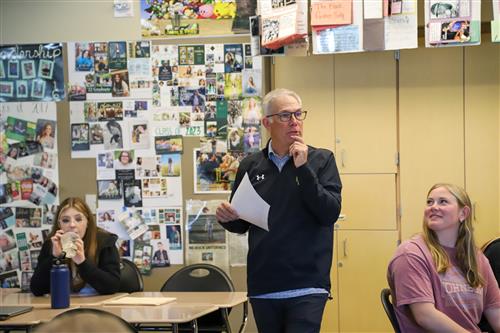
April 22 – 26 is National Student Leadership Week. We visited the leadership class at Shadle Park High School recently to see student leaders in action and how the leadership class has evolved.
In the leadership class at Shadle Park High School, 50 students spread out over two classrooms, in the school and across Spokane’s north side.
The hustle and bustle of the leadership class never stops. Some students are visiting feeder pattern elementary schools to mentor kids and spend time with them at recess. Others are in the gym practicing for the school’s upcoming spring sports pep con. Others are in the classroom creating materials for the upcoming talent show and the staff vs. students kickball match.
Student leadership classes in SPS high schools have evolved over the last few decades. In the past, seats at Shadle were limited to about 25 students who had to be juniors or seniors—generally those who were heavily involved in school activities.
Now, schools are opening more seats for students to be involved in school leadership. At Shadle, that meant getting a second teacher involved.
Scott Harmon and Brooke Meyer were both heavily involved in student leadership in their days as students at Shadle Park. Now teachers, they partnered three years ago to team up and advise the class, which allowed them to raise the total number of students to 50. They also opened it up to sophomores.
“We’re trying not to be exclusive,” Harmon said. “We are trying to get it so we are more inclusive by having a more broader swath of students, and not just those who are involved in other school activities.”
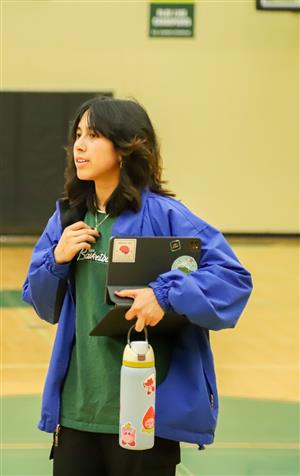
The traditional high school leadership class involved tons of activities – from pep cons to spirit games to school dances and other events. That hasn’t gone away, though it waxes and wanes each school year. Harmon and Meyer are interested in providing more lessons on leadership for their students.
“We’re looking at doing College in the Classroom next year in leadership, so that should ramp it up to teaching more leadership skills and not just activities. We need to teach within those activities,” Meyer said.
“There is a business leadership model, a military leadership model, and athletics and coaching leadership model – there are lots of different models, so we try and demonstrate those through actions,” Harmon added.
Harmon and Meyer have invited speakers to talk to the class about leadership and the skills necessary to be a good leader.
The class isn’t as predictable as, say, a history class with defined units throughout each semester. With so many activities and events happening in high school, leadership students are needed in a variety of ways.
“We’ve team taught for three years and have known each other for 30 years, and yet every day is something new,” Harmon said. “We never sit down and think, ‘What should we do today?’ You can’t do that in this class.”
The activities managed by the leadership class still offer valuable lessons that students will take with them after graduation.
“Leadership has been mislabeled an easy A, but the class has different levels of stress for different projects,” Harmon said. “We talk about stress for a final exam. Well, planning Groovy Shoes is a final exam in a major way. Or a school dance, or an event for our DI (Designed Instruction) program. It’s more of a life lesson on how you deal with adversity, how you deal with pressure, how you deal with communications, all those things.”
Harmon and Meyer learned those lessons at Shadle when they were in high school. Now, they’re teaching the same lessons and passing the baton to our future leaders.
-
Students at The Community School Team up with KREM 2 to Broadcast the TCS News Hour
Posted by The Community School on 4/11/2024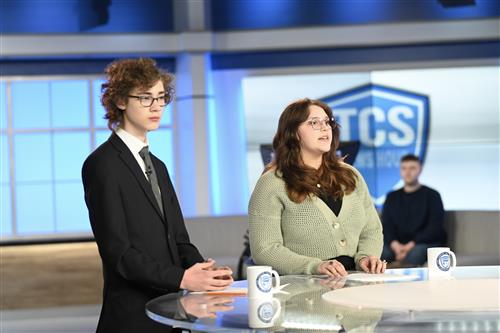
On February 5, 2024, juniors and seniors at The Community School (TCS), along with their facilitators Tami Linane-Booey and Nathan Seaburg, partnered with the national student journalism program, PBS Student Reporting Labs. The project, Student Reporters, asked students the question, How can we communicate complex ideas in an authoritative, balanced and effective manner?
Students were first introduced to the idea of journalistic writing and were challenged to craft a news article about a career in media. The students worked vigorously, researching and gathering feedback in order to produce their articles. Local journalists from KREM TV, The Inlander and The Spokesman-Review came to TCS to speak to students about their jobs and give advice.
Next, students looked at all the possible topics for the national contest, a chance to have their news story featured on PBS NewsHour. These groups then began to brainstorm and peruse the internet, narrowing down their main topic. They looked at the broad topics of gun violence, real life lessons, and book bans, and learned how to turn those topics into newsworthy stories. Each reporting team outlined, scripted, filmed and edited 3- to 5-minute news packages. Stories ranged from financial literacy laws, to how local authors deal with book bans, and stories on meditation in schools and the local music scene. Local PBS affiliate KSPS and representatives from Student Reporting Labs as well as Community Minded TV all supported students with expertise and equipment.
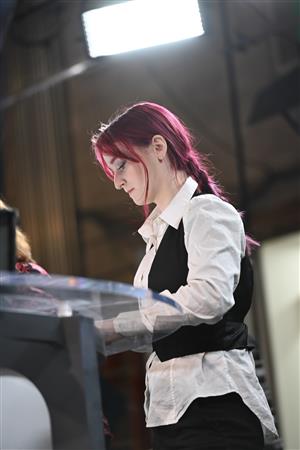
With two weeks left before the national contest deadline, students were given the option to take on a new challenge and make their own news hour. On Monday, March 11, this select group of students bused to KREM. Long-time reporter Laura Pepetti gave the students a tour and allowed us to watch her report during the noon broadcast.
Students went to work the next day. A student-run production team formed and jobs and deadlines created. They had three days to create a show! The following Monday, students arrived back at KREM, but this time they took over the studio! The logo, on-air graphics, and script were ready. Now, they recorded their written anchor segments. Laura Papetti and the rest of her team advised TCS students throughout the recordings, and gave meaningful feedback with tips on how to act on camera.
Back at TCS, they put it all together. Students scramble to complete last-minute edits, marketing, and even created public service announcements. A bonus for this team was lead editor, Devin Gibbs. Devin is the first student from TCS to be a part of the KSPS Media Makers internship. He has worked at KSPS all year, learning to edit and produce content. Head of graphics, Josephine Kahler, created the logo and supervised all the graphic contests. Josephine, a senior at TCS, spent their junior year in the graphic arts department at Skill Center.
“This project was a great way to explore new skills, and play to the strengths of different students,” Josephine said.
After editing all the news segments, creating all the graphic transitions, and making the sound just right, it is ready for prime time! Enjoy the show:
This blog was written by students at The Community School. Photographs taken by TCS junior Chase Dewey.
-
School libraries: How the space, and use, has changed
Posted by Ryan Lancaster on 4/9/2024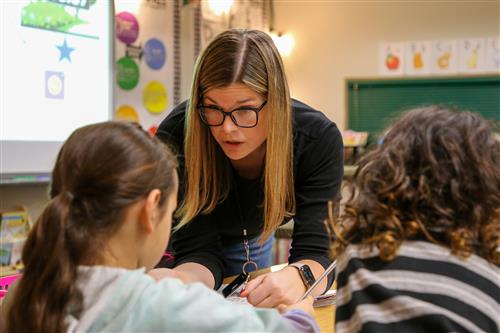
If you haven’t visited a school library in a while, you may picture a quiet home for dusty tomes, overseen by a shushing librarian and their well-ordered card catalog.
But the spaces – and the people who manage them – have evolved to be more open and engaging, offering access to 21st century technology and a range of learning for every age group.
They can even be – gasp – noisy.
“We let students eat and be loud in the library,” said Lewis & Clark High School Library Information Specialist (LIS), Mark Robbins. “We host a lot of after-school clubs. And it feels more like a coffee shop than a computer lab, which is what it felt like to me before.”
Students now bring their own laptops, and when Mark and fellow LIS Eric Woodard aren’t busy troubleshooting tech, they’re working to brand the library as a safe, comfortable place for all. The shelves are filled with locally purchased books co-curated by students and staff at the school. There's chess, a well-attended Nintendo and Dungeons & Dragons club, even sewing machines available for checkout.
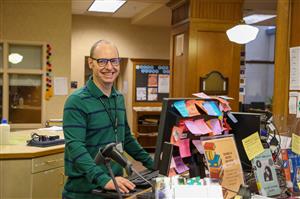
Thanks to more efficient systems, the process of checking out actual books takes up relatively little time, although Mark said he enjoys connecting with students over what they’re reading. He also coordinates with staff and teachers to promote literacy and finds resources to support what’s being taught in class.
“We want the library to be an extension of every classroom,” Mark said.
New space, new name
Instead of a library, the recently built Flett Middle School has a “learning commons,” which has few walls and is located at the heart of the building. It’s a busy place, where students are encouraged to work and create together.
LIS Michelle Meek said the space and furniture are designed to facilitate collaboration while still allowing students to find quiet when needed. Like her high school counterparts, she does much more than process book borrowing.
“We teach students how to use the self-check and Spokane Public Library resources so they have access to books anytime, which frees us to help students and teachers in other ways,” Michelle said.
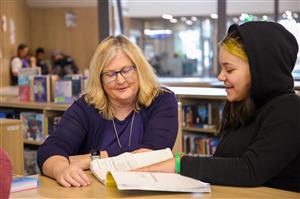
Most of that time is spent guiding students to be better learners by becoming adept at accessing information for research or personal interest, managing and using technology, growing into critical thinkers. "Sometimes we just provide a space and tools for them to take a break from the world,” she said. “What I love most about my job is that I get to connect with so many people for different purposes.”
Beyond storytime
A common misconception Katie Anderson hears about her job as Cooper Elementary School’s LIS is that it’s all about coloring, playing, and reading books with students.
“There are of course times those things happen, but the 45 minutes we get each week with students are all used intentionally,” she said. “Our instruction must align with American Association of School Librarian standards that correlate to the report card. We give grades based not only on observational data, but multiple assessment data points as well, just like their classroom teachers.”
Her students learn how to type, code, conduct ethical research, understand digital etiquette and safety, work with peers and much more. She collaborates with teachers to create interdisciplinary connections, helps students find great books and authors, and – yes – occasionally reads aloud to a group of rapt little people sitting crisscross applesauce.
“What I love most is getting to teach all the students every year and getting to know them all so well,” Katie said. “I get to witness their growth and build on each skill or process as they move towards middle school.”
All this happens in one moderately sized, very engaging space. Each square foot of the elementary library has a purpose, from Maker Spaces and story stairs to an interactive flat panel for students to manipulate. One area houses an audio book station for young readers while another hosts a KSPS PBS cart with iPads for classroom teacher checkout. There are book displays to pique student interest and curated bins of books based on each heritage month.
Katie sums it up: “The library is no longer a just a computer lab with books; it's become much more encompassing than that.”
-
Students, community make regalia for the first Pauline Flett Pow Wow
Posted by Theresa Tanner on 3/25/2024Originally published May 19, 2023
“For a long time, Indigenous people couldn’t be who we are – our culture was banned,” said SPS Native Education coordinator Tamika LaMere, a member of the Little Shell Tribe of Chippewa Indians. “For me personally, ribbon skirts and shirts are a symbol of Indigenous pride, of resiliency, of power. It shows that we are still here.”
This week, about 25 students, school staff and community members gathered at Flett Middle School for a Ribbon Skirt and Shirt making workshop with Spokane Schools Native Education, in preparation for the first ever Pauline Flett Pow Wow on Saturday, May 20, 11 a.m.-10 p.m.
In the later part of the 18th century, European colonizers brought silk ribbons and other items to trade with the Anishinaabe people in the Great Lakes region. The ribbons were used as an appliqué to decorate garments like skirts and shawls, and the craft was adopted by tribes throughout Turtle Island – the name of the North American continent among many Indigenous tribes.
The practice had all but vanished by the early 1900s as the U.S. government separated tribes from their homelands and ways of life, but a resurgence of Native American cultural traditions and activism helped to revive the craft in the 1970s. Today, garments adorned with ribbons are often worn at native cultural events, like pow wows. More information and history about ribbon work can be found at Milwaukee Public Museum.
At this week’s workshop, measurements were taken, then fabric was cut by Anna Eagle Bear, an SPS Multi-Tiered System of Supports specialist who is a member of the Diné tribe. Students, staff, and community volunteers cut ribbons and affixed them with basting adhesive before the fabric was sewn together. Everyone supported one another, whether showing someone how to use a sewing machine or helping to pick out and place ribbons.
“They can choose whatever fabric and colors speak to them as an individual,” Tamika said, as students laid out ribbons across patterned fabric.
See more photos of the activity on Facebook.
The students will have the opportunity to wear their regalia at the inaugural Pauline Flett Pow Wow on Saturday, which is being organized in collaboration with multiple individuals and organizations to honor Pauline Pascal Flett and her legacy; check out this video by KSPS to learn more about Spokane Tribe elder Pauline Flett and her lifelong efforts to save the Spokane Salish language:
Flett principal Dr. Matthew Henshaw hopes to expand opportunities for students to connect with Native cultural traditions next year, with more workshops to make regalia and learn songs and dances in preparation for the new tradition at the school.
Learn more about the first Pauline Flett Pow Wow and thank you to the community partners that are sponsoring this event: WSU Spokane Native American Health Sciences, Salish School of Spokane, The NATIVE Project, University of Washington, Sister Sky, Elk Soup, and Spokane Tribe of Indians.
-
Shadle Park students learn about Tuskegee legacy during Black History Month
Posted by Theresa Tanner on 3/6/2024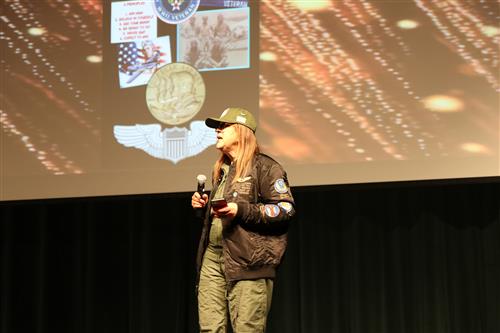
On Thursday, Feb. 29, Shadle Park High School’s College & Career Center hosted a special presentation for Black History Month: “The Power of Legacy: A Tuskegee Airman” featuring Rhonda Leonard-Horwith.
Ms. Leonard-Horwith, a retired attorney, is the daughter of retired United States Air Force Lt. Col. Harlan Quetin Leonard Jr. (1926-2023), a Documented Original Tuskegee Airmen (DOTA) who attended pilot training at Tuskegee in 1944.
Every week, Shadle Park High School College and Career Readiness Specialist April Eberhardt invites different speakers to share with students about their careers for “Empowerment Thursdays.”
“Students don’t know what they don’t know,” explained Ms. Eberhardt. “So this gives them some inspiration about what they may want to do, and find the personal connections with people about how they got where they were going.”
She’ll often ask students what they’re interested in – forensics, occupational therapy, banking, poetry – and reach out to professionals in those industries.
“Inspire, empower and expose,” is what Ms. Eberhardt wants for her students, so she can help them figure out what they need to do now as a student to make those dreams a reality – whether that’s filling out the FAFSA for financial aid to pursue college, vocational training, or an apprentice program, or coordinating internship opportunities for a student’s Career & Technical Education pathway.
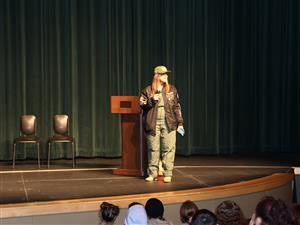
“Living history”
When Ms. Eberhardt met Ms. Leonard-Horwith and heard her story, she knew she had to get her in to speak with Shadle Park students.
“Her father was a trailblazer, but still experienced discrimination and segregation. It’s important for students to hear her story, especially for Black History Month. She’s living history.”In Shadle Park’s auditorium, dressed in a flight suit and jacket with Tuskegee and Air Force patches in honor of her father, Ms. Leonard-Horwith shared with students her and her father’s personal histories, as well as the challenges and impact of the first African American pilots for the United States military.
“They had a double victory because they had two wars to fight: One in Europe in World War II, and one in America against segregation,” she told students, emphasizing that military leaders even doubted that Black pilots could fly aircrafts until First Lady Eleanor Roosevelt took a flight with aviator Charles Alfred Anderson Sr. in 1941.
Ms. Leonard-Horwith spoke about growing up on military bases in Maryland, where Black service members had a 4 p.m. curfew because it was too dangerous in the area for them to be out after dark. “I was sick with worry for my father.”
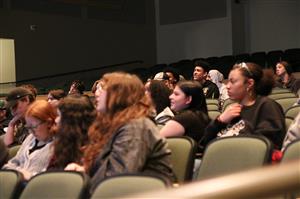
She also experienced discrimination herself, as her high school guidance counselor discouraged her from going to college. “’You people don’t do well there, you cook there,’” she was told. She was accepted to several universities, including her alma mater, the University of California, Riverside.
And her father always challenged her to do better than him. “He had one degree, so I got two.” She shared about her professional goals and accomplishments, and how she follows the Six Guiding Principles of Tuskegee Airmen: Aim High, Use Your Brain, Believe in Yourself, Be Ready to Go, Expect to Win and Never Quit.
It has been an honor for Ms. Leonard-Horwith to see her father and the legacy of Tuskegee airmen honored in recent years with a Congressional Gold Medal, floats in parades, statues and memorials in the United State and Italy, and even a big screen portrayal in the 2012 film “Red Tails.”
“It was a wonderful presentation,” Shadle sophomore Nikita Habimana said. “It was insightful and enlightening. It’s inspiring for young people of color – for everyone – because it helps us see that we can do anything we put our minds to.”
-
National School Counseling Week: Emily Magnuson and Alicia Shenefelt
Posted by Kevin Dudley on 2/9/2024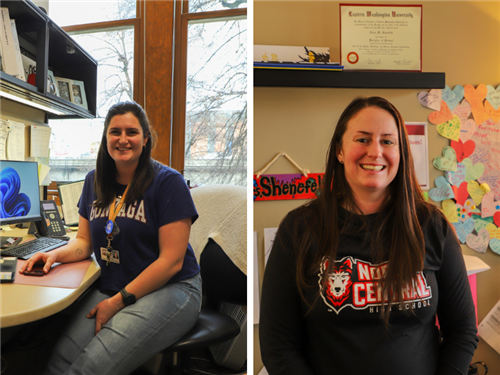
Emily Magnuson is a counselor at Lewis & Clark High School, where she works with ninth graders and English Language Learners (ELL)—students of all high school grades who recently relocated to the United States.
Emily’s been at Lewis & Clark since 2021 and has been a school counselor since 2017.
As part of National School Counseling Week, Emily sat down with us to share her unique role.
What are the needs of your students?
With my ninth-grade students, I’d say the biggest needs are lessons on time management, communication, navigating social relationships and self-advocacy. I help them communicate accurately with their parents or guardians about their grades and help them stay ahead of things instead of playing catch up. I also do a lot of general time management process lessons with them to help them map out their time. That transition from middle school to high school can be difficult for some.With my English Language Learner students, it really depends on their situation and where they’re coming from. I’ve worked with a lot of refugee students and students who have lived in the U.S. for several years but are still receiving English services. The cultural complexities of joining a U.S. high school are very challenging. We also work on expectations, how we process things, how transcripts are evaluated, how credits are awarded—there’s a huge learning curve. I’ve also worked with kids who’ve never seen a computer before. That enrollment meeting and learning curve is going to look a lot different than a ninth grader transferring in from another school.
Going from living in a refugee camp or different countries to our school system is a big change. The differences in dress, interaction, social/cultural norms, all those things are sitting in front of me. I’ve had students who’ve fled war torn areas, so, for instance, emergency protocols and drills can be very triggering. So, there are the nuts and bolts of the job like classes, credits, and learning, but there’s also the dynamic of becoming part of the U.S. culture and what our school system looks like. It just comes down to experience and empathizing with them and listening to their stories and getting to know them on an individual level.
What kinds of things do you address when students come to your office?
It’s such a wide spectrum. It’s anything from future planning careers and higher education and graduation planning to crisis response, mental health needs, students’ relationships, career goals, dealing with culture clashes. You name it, in an hour I can see all those things.What’s something the public might not know about school counselors?
At their core, counselors are strong student advocates and have a very unique opportunity to support students in the in-between. When you think of school, you think of math, science, English. We’re the gel that holds all that together.The role of the school counselor has evolved and continues to do so. It’s so much more than organizing student schedules. Every child is important to us.
Alicia Shenefelt is the ninth grade counselor at North Central High School, a place she’s been for the past four years. She has nine years of experience as a school counselor.
As part of National School Counseling Week, Spokane Public Schools is featuring counselors from its schools all week. Alicia sat down with us recently to share what she sees everyday in her role at North Central.
What are the needs of your high school students?
Right now with freshman, we’re working on school behaviors like staying in class, getting assignments done, prioritizing, communicating, follow-through, responsibility, those kinds of things.We also have a ninth grade homework center, which is really rad. Staff help students with goals, grades, communication with teachers, advocating for themselves and just overall responsibility and accountability that is a step up from middle school.
What do high school counselors focus on at each grade level?
In 10th grade, it’s still a little bit more about fine tuning skills and building their academic confidence. By 10th grade hopefully they have some credits under their belt and we’re making bigger plans, which is fun.By junior year, a lot of different doors open. They can go to NEWTech, and On Track Academy opens up to students. We also get to talk about college and post-high school. Junior year is still the hardest academically, which is cool because they’re ready for it.
Senior year is so much of making sure we’ve met every requirement, making sure that kids who are ready for college are getting their applications in and their FAFSA done. We communicate with parents a lot and answer all the questions that have to do with having a senior in high school.
With such a large student body in our high schools, what’s the range of things counselors address?
In just the last week alone, we’ve had things range from ‘My boyfriend broke up with me,’ or ‘I lost this paper,’ or ‘I’m having bad thoughts and I need help,’ and everything in between. We have some freshman who are still young in their minds, and that’s fine because it’s developmentally appropriate. So, it’s ‘My friend is mad at me,’ to ‘I can’t find my paper and my mom will be mad because my grade will be lower’ to ‘We’re going to be homeless tomorrow.’ So, we have a huge variety of needs, and that is the same for every grade level.There’s a big prioritizing piece for counselors. You can have a list of what you’re doing that day, but if a kid comes in with some big mental health needs or at-home needs, those things always come first. We never know who’s going to walk in the door.
What is something the public might not know about high school counselors?
A school counselor is kind of a gatekeeper. We’re not a mental health therapist, we’re not an academic specialist. We get to kind of field the different resources. When students come in the door, we find what will work for them. Oftentimes that helps us build a relationship and can have a check-in. We’re not a weekly meeting resource. We refer out to others for that.Over the four years, we do get to see each kid for a different reason, which is cool. We get to spend time with everybody.
-
National School Counseling Week: Kitty Hennessey, Flett Middle School
Posted by Kevin Dudley on 2/7/2024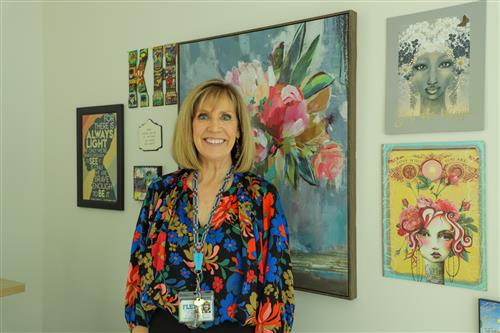
Kitty Hennessey has approximately 30 years of experience as a school counselor. She’s been in elementary schools, middle schools and high schools. Currently, she is the counselor for all seventh grade students and half of the sixth grade class at Flett Middle School.
As part of National School Counseling Week, we sat down with Kitty to learn about her role as a school counselor for middle school students.
What are the needs of middle school students?
This age is the biggest point of growth they will have physically, emotionally, with their brain, since they were born. If you think about the amount of change they’re dealing with, it’s huge. We have kids dealing with things developmentally and we try and figure out how to regulate, how to be a student, and all of this is on top of the needs in their environment, which can be hard.Middle school kids, because of their development, don’t always read things correctly. So, sometimes they interpret conflict or stress differently from what it might be in reality. They think people are mad at them a lot, when it’s really just, ‘Oh, I just told you sit down until ten after.’ We do a lot of helping them regulate those emotions.
It’s also a hard time for parents. Kids are high energy at home and here. They need a lot of love and care. They need strong boundaries, high love and high expectations.
From a counselor’s point of view, what’s the focus on this age level?
First and foremost, it’s teaching them how to regulate. If they’re not regulated, they can’t do what they need to do, so we help them build the tools to regulate. Elementary schools do a nice job of starting that process and it’s really important for us to use the same lessons and put it into practice here so we can pass them on to high school.Discipline and those things are important and we’re part of that, but we’re here to help them prepare and learn the skills to get along.
What growth do you see from grade 6 to 8?
First of all, they’re not going to look the same. We can laugh at that, but it’s a big deal. It’s also emotional growth. They’ll make huge growth one year and I say, ‘I want you to remember this feeling.’ Then when they get to eighth grade, we can say, ‘Do you remember?’ and they say, ‘Yes!’ and they laugh at the feeling of growth.We teach that hopefulness, that things get better. Sometimes kids get stuck in it and don’t know how to get out and can’t see that life will get better.
Social media is also really hard on our middle schoolers. They want it, but they can’t always make sense of it. It’s 24/7 and it’s a lot to ask of middle school kids.
What’s something the public might not know about middle school counselors?
Sometimes it’s like triage. I can set my day, but I never know what it’ll be like, which is part of what I like. I get to think about things deeply every day. Middle schoolers are hilarious. I cry, and there are things that should move you to tears because students are dealing with a lot. And then there are things that make me think deeply. I often think, ‘How can I be an agent for positive things?’ or something will present itself and I need to think creatively and be part of a plan. I would also say it’s one of the most hopeful age groups because you see change, and right before your eyes sometimes. -
National School Counseling Week: Mary Wetzel, Lincoln Heights Elementary
Posted by Kevin Dudley on 2/5/2024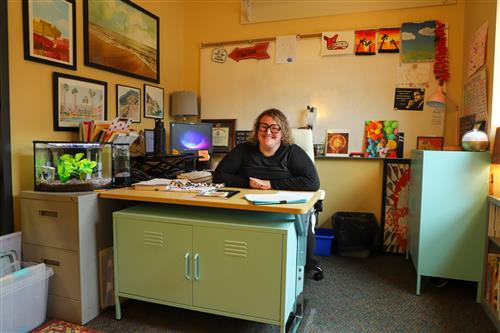
Mary Wetzel has been a school counselor for 11 years at Lincoln Heights Elementary and was previously a school counselor at Chase Middle School and Ferris High School.
As part of National School Counseling Week, Spokane Public Schools is featuring counselors from its schools all week. Mary sat down with us recently to share the ins and outs of her role at Lincoln Heights.
What are the general needs of your students?
When a kid enters my office, I first look at their basic needs. ‘Are you hungry? Are you tired? Do you need a hug?’ That has really helped. Most of our kids just need stability and predictability just like any kid. We get a lot of support from our staff and the community with things like clothes and food and support with their academics.Counselors are out and about in classrooms. What kinds of lessons are you teaching in elementary classrooms?
We approach lessons differently for each grade level, but overall we look at mindfulness a lot and I support the Purposeful People lessons in elementary.We know the research around mindfulness is really helpful for kids. We help them with managing behavior and emotions, and also perseverance and getting through things that are tricky for them, whether home is hard and they need to transition to school, or school is hard and they need to navigate their seven-plus hours here. We build those skills so when they move on to middle school, they can take a minute to take care of themselves first and then manage whatever thing they’re dealing with.
What is most rewarding about being a school counselor?
The kids. Being in elementary school is really neat because I have many of these students for a long time. Watching them grow, watching them learn and be proud of themselves is great. We grow relationships with their parents and are partners with them in supporting their student.Every morning my principal and I will stand at the front door to say good morning, and you can kind of just set their day and that is very rewarding. When you see them have their little wins and can be that person that can safely listen to them when they’re having a hard day, it’s rewarding.
We just want students in school and to spend time with them and take care of them. I think it’s a huge blessing that someone is letting us take care of their kids for hours in the day and we must honor that gift.
What is something the public might not know about school counselors?
The job can be very different from building to building and day to day. Some days you’re a social worker, some days you’re teaching a lesson in the classroom. Some days you’re helping with day-to-day issues. There’s not a lot of predictability, and it’s never cut and dry. It’s responsive and you don’t always know what the day is like and how a kid will come to school. But we’re here for it. Our job is to be responsive to the needs of our kids and that can change minute to minute or week to week. -
Public pickleball courts coming soon to a school near you
Posted by Ryan Lancaster on 1/30/2024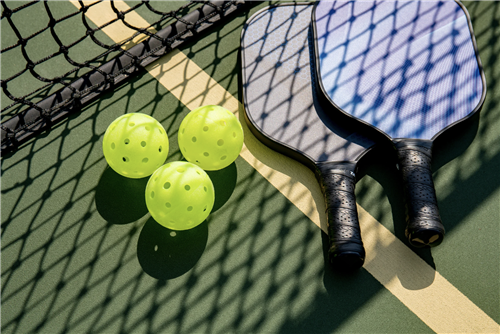
Pickleball was established as Washington state’s official sport in 2022 and is now the fastest growing sport in America.
Local fans will have more places to work on their ace this summer, thanks to a Spokane Public Schools initiative to create 14 new public access courts across the city.
After hearing from community members about their love of the game, SPS is making accommodations to existing tennis courts at Rogers, Shadle Park, and North Central high schools to create a total of six pickleball courts on the north side of the city. Ferris High School and Lewis and Clark’s Hart Field will each have two tennis courts adapted to make another eight pickleball courts available on the south hill. This will support both school-based programming and community use.
Pickleball was born in 1965 on Bainbridge Island, Washington. While it can be played in or out of doors, outdoor courts in the Spokane area have been limited.
“At Comstock Park, there will be 40 to 50 people playing pickleball,” said former SPS superintendent Dr. Gary Livingston, who has been playing pickleball since 2012. “So those courts at the high schools will definitely be used.”
Livingston said the sport’s “forgiving nature” makes it accessible for retirees like he and his wife. It’s not too hard on the knees, and it’s a great social activity.
“I participate in a group that plays pickleball twice a week,” he said. “This would be great for the community because the school district is contributing to the social connectivity of retired people.”
While details regarding reservations and availability are still to come, Spokane Public Schools is proud to provide what the public has been asking for.
“I think any time the school can give back to the community that supports it and continues to support it, is a powerful message,” said Livingston.
Recent
By Month
- April 2024
- March 2024
- February 2024
- January 2024
- November 2023
- October 2023
- September 2023
- August 2023
- July 2023
- June 2023
- May 2023
- April 2023
- March 2023
- February 2023
- January 2023
- December 2022
- November 2022
- October 2022
- September 2022
- August 2022
- July 2022
- June 2022
- May 2022
- April 2022
- March 2022
- February 2022
- January 2022
- December 2021
- November 2021
- October 2021
- September 2021
- August 2021
- July 2021
- June 2021
- May 2021
- April 2021
- March 2021
- February 2021
- December 2020
- November 2020
- October 2020
- March 2020
- November 2019
- October 2019
- May 2019
- April 2019
- February 2019
- January 2019
- November 2018
- October 2018
- September 2018

